Critical Appraisal of a Case-Control Study on ZIKV and Microcephaly
VerifiedAdded on 2020/02/24
|8
|2300
|55
Report
AI Summary
This report presents a critical appraisal of a case-control study that investigated the association between Zika virus (ZIKV) infection during pregnancy and neonatal microcephaly in Brazil. The study design, involving cases and controls, aimed to determine the relationship between ZIKV and microcephaly. The appraisal evaluates the study's methodology, including sample selection, matching of cases and controls, and the analysis of study factors like ZIKV exposure. Strengths of the study include its focus on a multi-typic flavi-viral infection and the use of FDA-sanctioned diagnostic tests. Limitations include potential biases from interim analysis and lack of CSF samples from controls. The report discusses the study's findings, including the calculated odds ratios, and its conclusions about the link between ZIKV and microcephaly, recommending measures to prevent its transmission and manage affected neonates. The report also addresses the study's significance for public health and its implications for healthcare professionals.
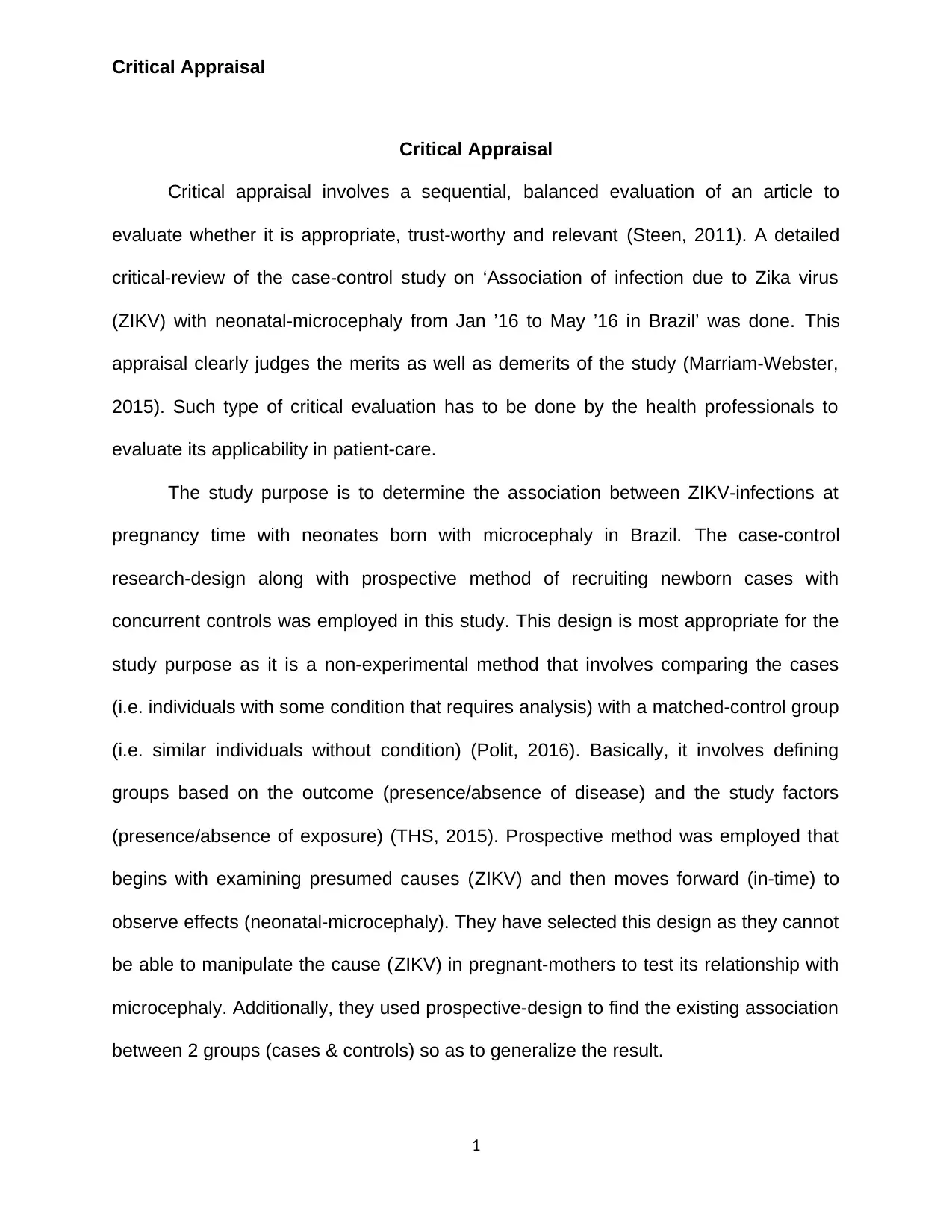
Critical Appraisal
Critical Appraisal
Critical appraisal involves a sequential, balanced evaluation of an article to
evaluate whether it is appropriate, trust-worthy and relevant (Steen, 2011). A detailed
critical-review of the case-control study on ‘Association of infection due to Zika virus
(ZIKV) with neonatal-microcephaly from Jan ’16 to May ’16 in Brazil’ was done. This
appraisal clearly judges the merits as well as demerits of the study (Marriam-Webster,
2015). Such type of critical evaluation has to be done by the health professionals to
evaluate its applicability in patient-care.
The study purpose is to determine the association between ZIKV-infections at
pregnancy time with neonates born with microcephaly in Brazil. The case-control
research-design along with prospective method of recruiting newborn cases with
concurrent controls was employed in this study. This design is most appropriate for the
study purpose as it is a non-experimental method that involves comparing the cases
(i.e. individuals with some condition that requires analysis) with a matched-control group
(i.e. similar individuals without condition) (Polit, 2016). Basically, it involves defining
groups based on the outcome (presence/absence of disease) and the study factors
(presence/absence of exposure) (THS, 2015). Prospective method was employed that
begins with examining presumed causes (ZIKV) and then moves forward (in-time) to
observe effects (neonatal-microcephaly). They have selected this design as they cannot
be able to manipulate the cause (ZIKV) in pregnant-mothers to test its relationship with
microcephaly. Additionally, they used prospective-design to find the existing association
between 2 groups (cases & controls) so as to generalize the result.
1
Critical Appraisal
Critical appraisal involves a sequential, balanced evaluation of an article to
evaluate whether it is appropriate, trust-worthy and relevant (Steen, 2011). A detailed
critical-review of the case-control study on ‘Association of infection due to Zika virus
(ZIKV) with neonatal-microcephaly from Jan ’16 to May ’16 in Brazil’ was done. This
appraisal clearly judges the merits as well as demerits of the study (Marriam-Webster,
2015). Such type of critical evaluation has to be done by the health professionals to
evaluate its applicability in patient-care.
The study purpose is to determine the association between ZIKV-infections at
pregnancy time with neonates born with microcephaly in Brazil. The case-control
research-design along with prospective method of recruiting newborn cases with
concurrent controls was employed in this study. This design is most appropriate for the
study purpose as it is a non-experimental method that involves comparing the cases
(i.e. individuals with some condition that requires analysis) with a matched-control group
(i.e. similar individuals without condition) (Polit, 2016). Basically, it involves defining
groups based on the outcome (presence/absence of disease) and the study factors
(presence/absence of exposure) (THS, 2015). Prospective method was employed that
begins with examining presumed causes (ZIKV) and then moves forward (in-time) to
observe effects (neonatal-microcephaly). They have selected this design as they cannot
be able to manipulate the cause (ZIKV) in pregnant-mothers to test its relationship with
microcephaly. Additionally, they used prospective-design to find the existing association
between 2 groups (cases & controls) so as to generalize the result.
1
Paraphrase This Document
Need a fresh take? Get an instant paraphrase of this document with our AI Paraphraser
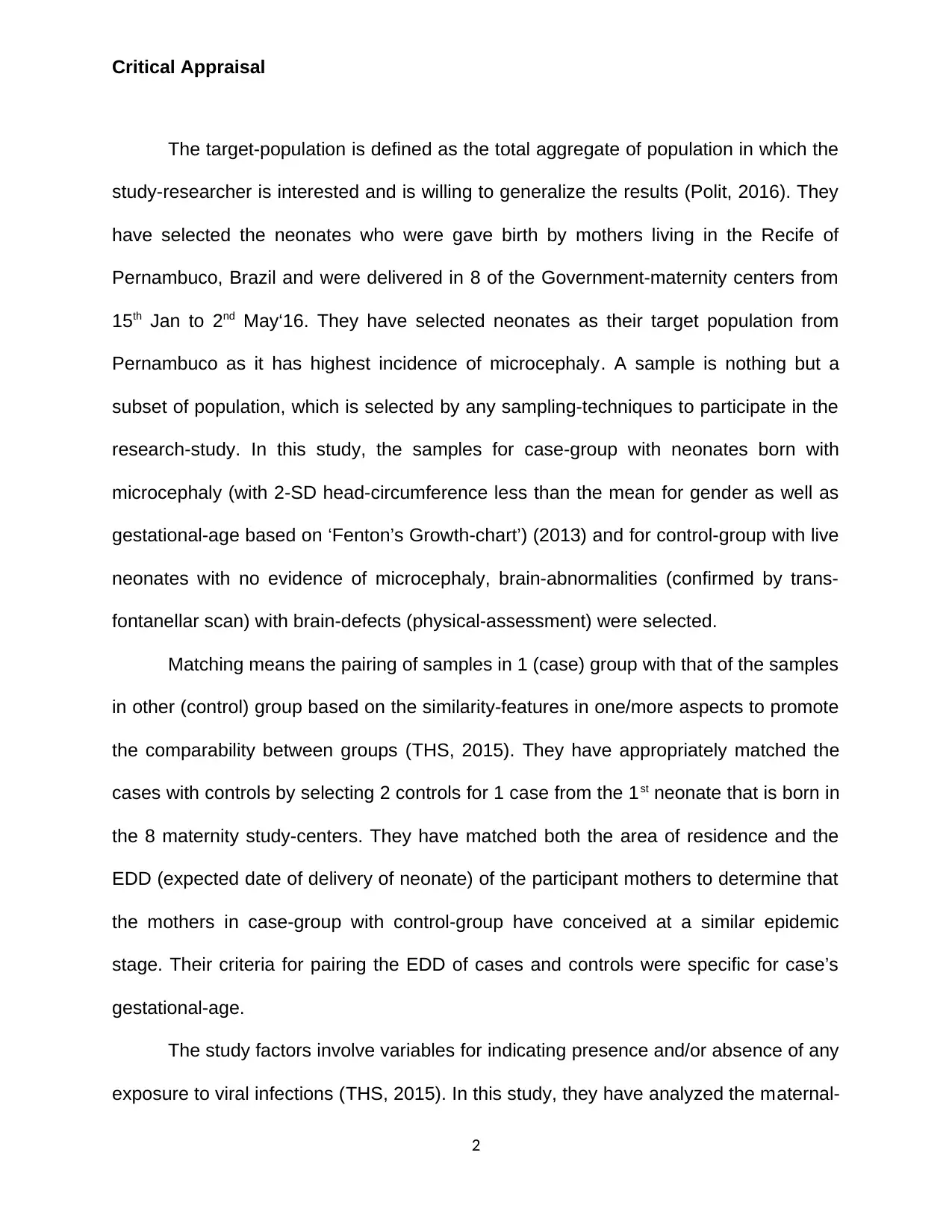
Critical Appraisal
The target-population is defined as the total aggregate of population in which the
study-researcher is interested and is willing to generalize the results (Polit, 2016). They
have selected the neonates who were gave birth by mothers living in the Recife of
Pernambuco, Brazil and were delivered in 8 of the Government-maternity centers from
15th Jan to 2nd May‘16. They have selected neonates as their target population from
Pernambuco as it has highest incidence of microcephaly. A sample is nothing but a
subset of population, which is selected by any sampling-techniques to participate in the
research-study. In this study, the samples for case-group with neonates born with
microcephaly (with 2-SD head-circumference less than the mean for gender as well as
gestational-age based on ‘Fenton’s Growth-chart’) (2013) and for control-group with live
neonates with no evidence of microcephaly, brain-abnormalities (confirmed by trans-
fontanellar scan) with brain-defects (physical-assessment) were selected.
Matching means the pairing of samples in 1 (case) group with that of the samples
in other (control) group based on the similarity-features in one/more aspects to promote
the comparability between groups (THS, 2015). They have appropriately matched the
cases with controls by selecting 2 controls for 1 case from the 1st neonate that is born in
the 8 maternity study-centers. They have matched both the area of residence and the
EDD (expected date of delivery of neonate) of the participant mothers to determine that
the mothers in case-group with control-group have conceived at a similar epidemic
stage. Their criteria for pairing the EDD of cases and controls were specific for case’s
gestational-age.
The study factors involve variables for indicating presence and/or absence of any
exposure to viral infections (THS, 2015). In this study, they have analyzed the maternal-
2
The target-population is defined as the total aggregate of population in which the
study-researcher is interested and is willing to generalize the results (Polit, 2016). They
have selected the neonates who were gave birth by mothers living in the Recife of
Pernambuco, Brazil and were delivered in 8 of the Government-maternity centers from
15th Jan to 2nd May‘16. They have selected neonates as their target population from
Pernambuco as it has highest incidence of microcephaly. A sample is nothing but a
subset of population, which is selected by any sampling-techniques to participate in the
research-study. In this study, the samples for case-group with neonates born with
microcephaly (with 2-SD head-circumference less than the mean for gender as well as
gestational-age based on ‘Fenton’s Growth-chart’) (2013) and for control-group with live
neonates with no evidence of microcephaly, brain-abnormalities (confirmed by trans-
fontanellar scan) with brain-defects (physical-assessment) were selected.
Matching means the pairing of samples in 1 (case) group with that of the samples
in other (control) group based on the similarity-features in one/more aspects to promote
the comparability between groups (THS, 2015). They have appropriately matched the
cases with controls by selecting 2 controls for 1 case from the 1st neonate that is born in
the 8 maternity study-centers. They have matched both the area of residence and the
EDD (expected date of delivery of neonate) of the participant mothers to determine that
the mothers in case-group with control-group have conceived at a similar epidemic
stage. Their criteria for pairing the EDD of cases and controls were specific for case’s
gestational-age.
The study factors involve variables for indicating presence and/or absence of any
exposure to viral infections (THS, 2015). In this study, they have analyzed the maternal-
2
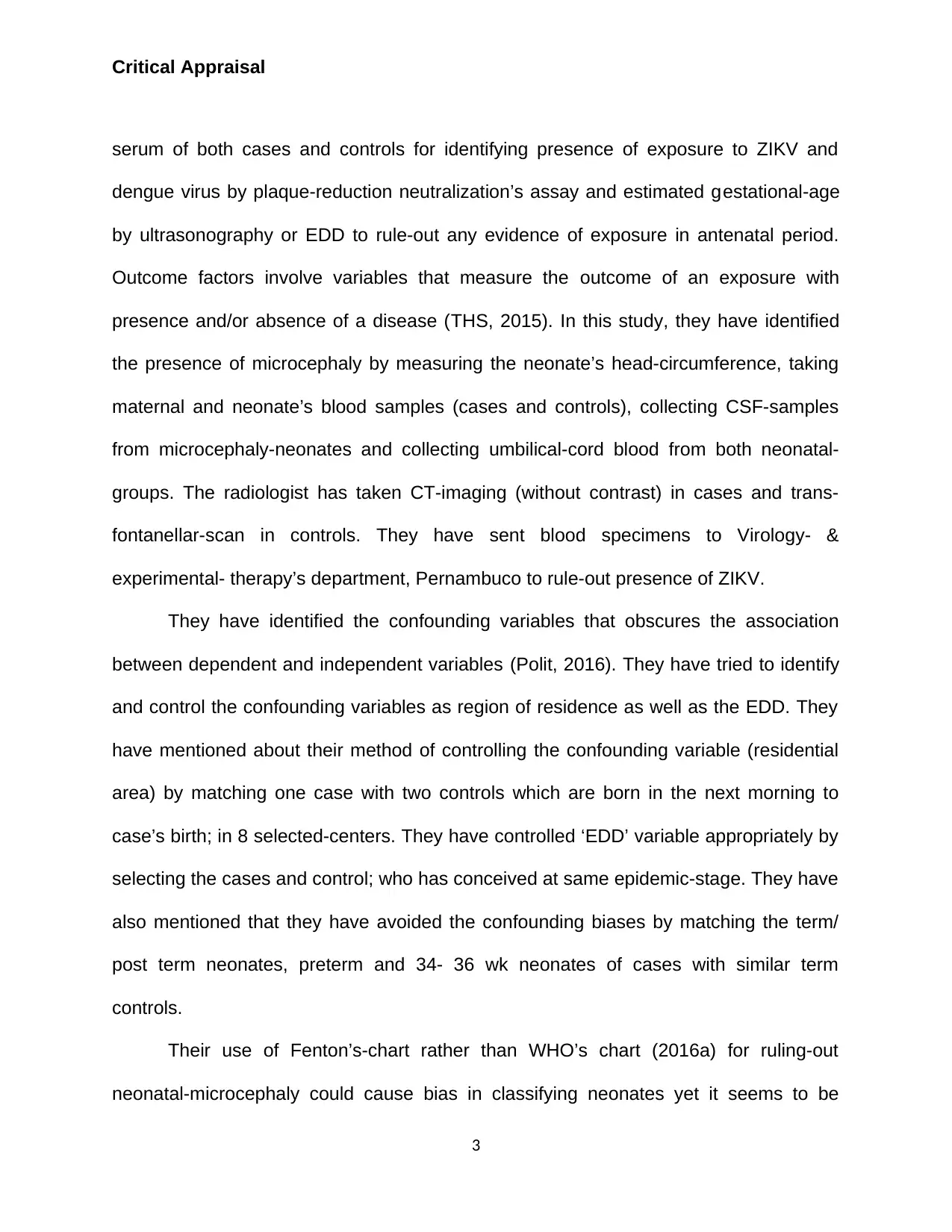
Critical Appraisal
serum of both cases and controls for identifying presence of exposure to ZIKV and
dengue virus by plaque-reduction neutralization’s assay and estimated gestational-age
by ultrasonography or EDD to rule-out any evidence of exposure in antenatal period.
Outcome factors involve variables that measure the outcome of an exposure with
presence and/or absence of a disease (THS, 2015). In this study, they have identified
the presence of microcephaly by measuring the neonate’s head-circumference, taking
maternal and neonate’s blood samples (cases and controls), collecting CSF-samples
from microcephaly-neonates and collecting umbilical-cord blood from both neonatal-
groups. The radiologist has taken CT-imaging (without contrast) in cases and trans-
fontanellar-scan in controls. They have sent blood specimens to Virology- &
experimental- therapy’s department, Pernambuco to rule-out presence of ZIKV.
They have identified the confounding variables that obscures the association
between dependent and independent variables (Polit, 2016). They have tried to identify
and control the confounding variables as region of residence as well as the EDD. They
have mentioned about their method of controlling the confounding variable (residential
area) by matching one case with two controls which are born in the next morning to
case’s birth; in 8 selected-centers. They have controlled ‘EDD’ variable appropriately by
selecting the cases and control; who has conceived at same epidemic-stage. They have
also mentioned that they have avoided the confounding biases by matching the term/
post term neonates, preterm and 34- 36 wk neonates of cases with similar term
controls.
Their use of Fenton’s-chart rather than WHO’s chart (2016a) for ruling-out
neonatal-microcephaly could cause bias in classifying neonates yet it seems to be
3
serum of both cases and controls for identifying presence of exposure to ZIKV and
dengue virus by plaque-reduction neutralization’s assay and estimated gestational-age
by ultrasonography or EDD to rule-out any evidence of exposure in antenatal period.
Outcome factors involve variables that measure the outcome of an exposure with
presence and/or absence of a disease (THS, 2015). In this study, they have identified
the presence of microcephaly by measuring the neonate’s head-circumference, taking
maternal and neonate’s blood samples (cases and controls), collecting CSF-samples
from microcephaly-neonates and collecting umbilical-cord blood from both neonatal-
groups. The radiologist has taken CT-imaging (without contrast) in cases and trans-
fontanellar-scan in controls. They have sent blood specimens to Virology- &
experimental- therapy’s department, Pernambuco to rule-out presence of ZIKV.
They have identified the confounding variables that obscures the association
between dependent and independent variables (Polit, 2016). They have tried to identify
and control the confounding variables as region of residence as well as the EDD. They
have mentioned about their method of controlling the confounding variable (residential
area) by matching one case with two controls which are born in the next morning to
case’s birth; in 8 selected-centers. They have controlled ‘EDD’ variable appropriately by
selecting the cases and control; who has conceived at same epidemic-stage. They have
also mentioned that they have avoided the confounding biases by matching the term/
post term neonates, preterm and 34- 36 wk neonates of cases with similar term
controls.
Their use of Fenton’s-chart rather than WHO’s chart (2016a) for ruling-out
neonatal-microcephaly could cause bias in classifying neonates yet it seems to be
3
⊘ This is a preview!⊘
Do you want full access?
Subscribe today to unlock all pages.

Trusted by 1+ million students worldwide
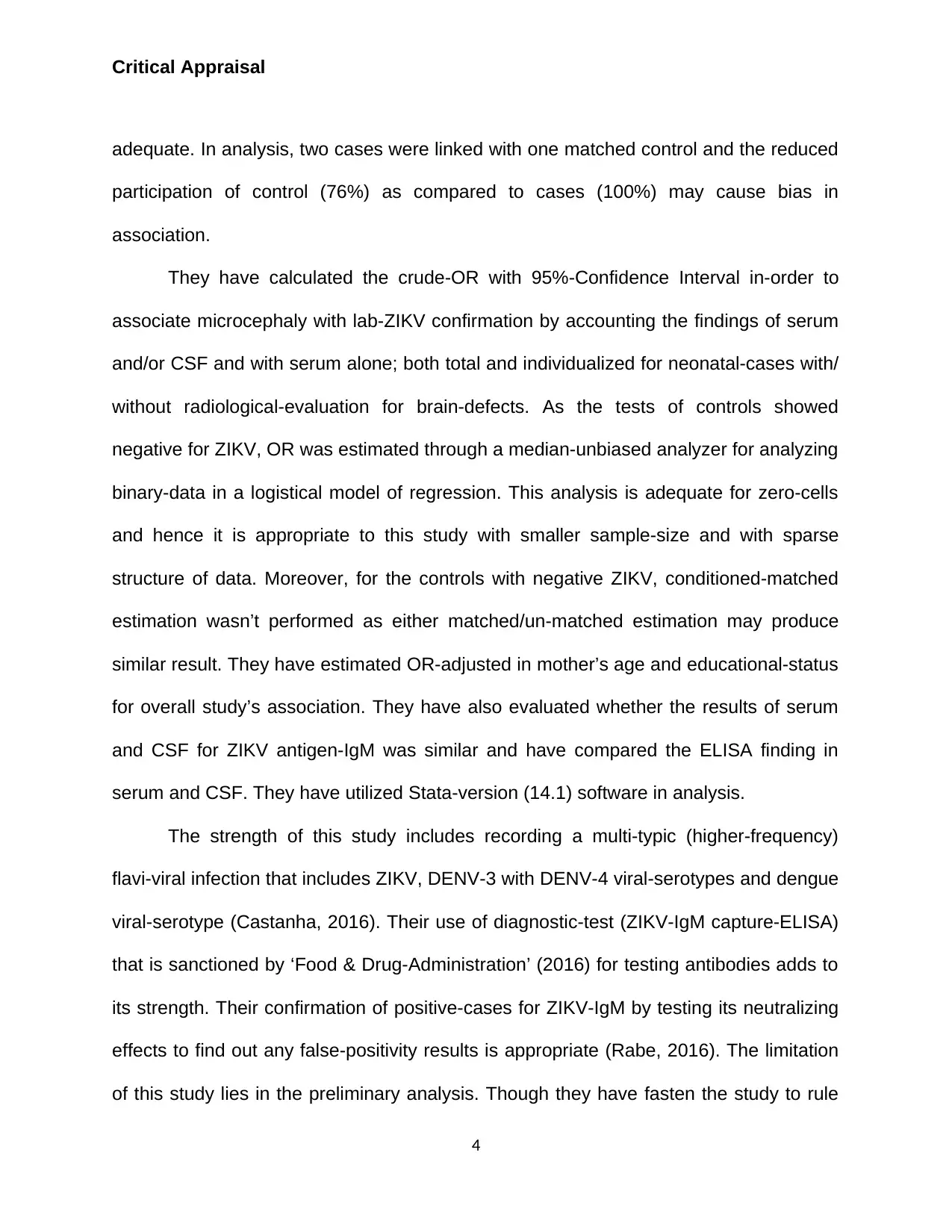
Critical Appraisal
adequate. In analysis, two cases were linked with one matched control and the reduced
participation of control (76%) as compared to cases (100%) may cause bias in
association.
They have calculated the crude-OR with 95%-Confidence Interval in-order to
associate microcephaly with lab-ZIKV confirmation by accounting the findings of serum
and/or CSF and with serum alone; both total and individualized for neonatal-cases with/
without radiological-evaluation for brain-defects. As the tests of controls showed
negative for ZIKV, OR was estimated through a median-unbiased analyzer for analyzing
binary-data in a logistical model of regression. This analysis is adequate for zero-cells
and hence it is appropriate to this study with smaller sample-size and with sparse
structure of data. Moreover, for the controls with negative ZIKV, conditioned-matched
estimation wasn’t performed as either matched/un-matched estimation may produce
similar result. They have estimated OR-adjusted in mother’s age and educational-status
for overall study’s association. They have also evaluated whether the results of serum
and CSF for ZIKV antigen-IgM was similar and have compared the ELISA finding in
serum and CSF. They have utilized Stata-version (14.1) software in analysis.
The strength of this study includes recording a multi-typic (higher-frequency)
flavi-viral infection that includes ZIKV, DENV-3 with DENV-4 viral-serotypes and dengue
viral-serotype (Castanha, 2016). Their use of diagnostic-test (ZIKV-IgM capture-ELISA)
that is sanctioned by ‘Food & Drug-Administration’ (2016) for testing antibodies adds to
its strength. Their confirmation of positive-cases for ZIKV-IgM by testing its neutralizing
effects to find out any false-positivity results is appropriate (Rabe, 2016). The limitation
of this study lies in the preliminary analysis. Though they have fasten the study to rule
4
adequate. In analysis, two cases were linked with one matched control and the reduced
participation of control (76%) as compared to cases (100%) may cause bias in
association.
They have calculated the crude-OR with 95%-Confidence Interval in-order to
associate microcephaly with lab-ZIKV confirmation by accounting the findings of serum
and/or CSF and with serum alone; both total and individualized for neonatal-cases with/
without radiological-evaluation for brain-defects. As the tests of controls showed
negative for ZIKV, OR was estimated through a median-unbiased analyzer for analyzing
binary-data in a logistical model of regression. This analysis is adequate for zero-cells
and hence it is appropriate to this study with smaller sample-size and with sparse
structure of data. Moreover, for the controls with negative ZIKV, conditioned-matched
estimation wasn’t performed as either matched/un-matched estimation may produce
similar result. They have estimated OR-adjusted in mother’s age and educational-status
for overall study’s association. They have also evaluated whether the results of serum
and CSF for ZIKV antigen-IgM was similar and have compared the ELISA finding in
serum and CSF. They have utilized Stata-version (14.1) software in analysis.
The strength of this study includes recording a multi-typic (higher-frequency)
flavi-viral infection that includes ZIKV, DENV-3 with DENV-4 viral-serotypes and dengue
viral-serotype (Castanha, 2016). Their use of diagnostic-test (ZIKV-IgM capture-ELISA)
that is sanctioned by ‘Food & Drug-Administration’ (2016) for testing antibodies adds to
its strength. Their confirmation of positive-cases for ZIKV-IgM by testing its neutralizing
effects to find out any false-positivity results is appropriate (Rabe, 2016). The limitation
of this study lies in the preliminary analysis. Though they have fasten the study to rule
4
Paraphrase This Document
Need a fresh take? Get an instant paraphrase of this document with our AI Paraphraser
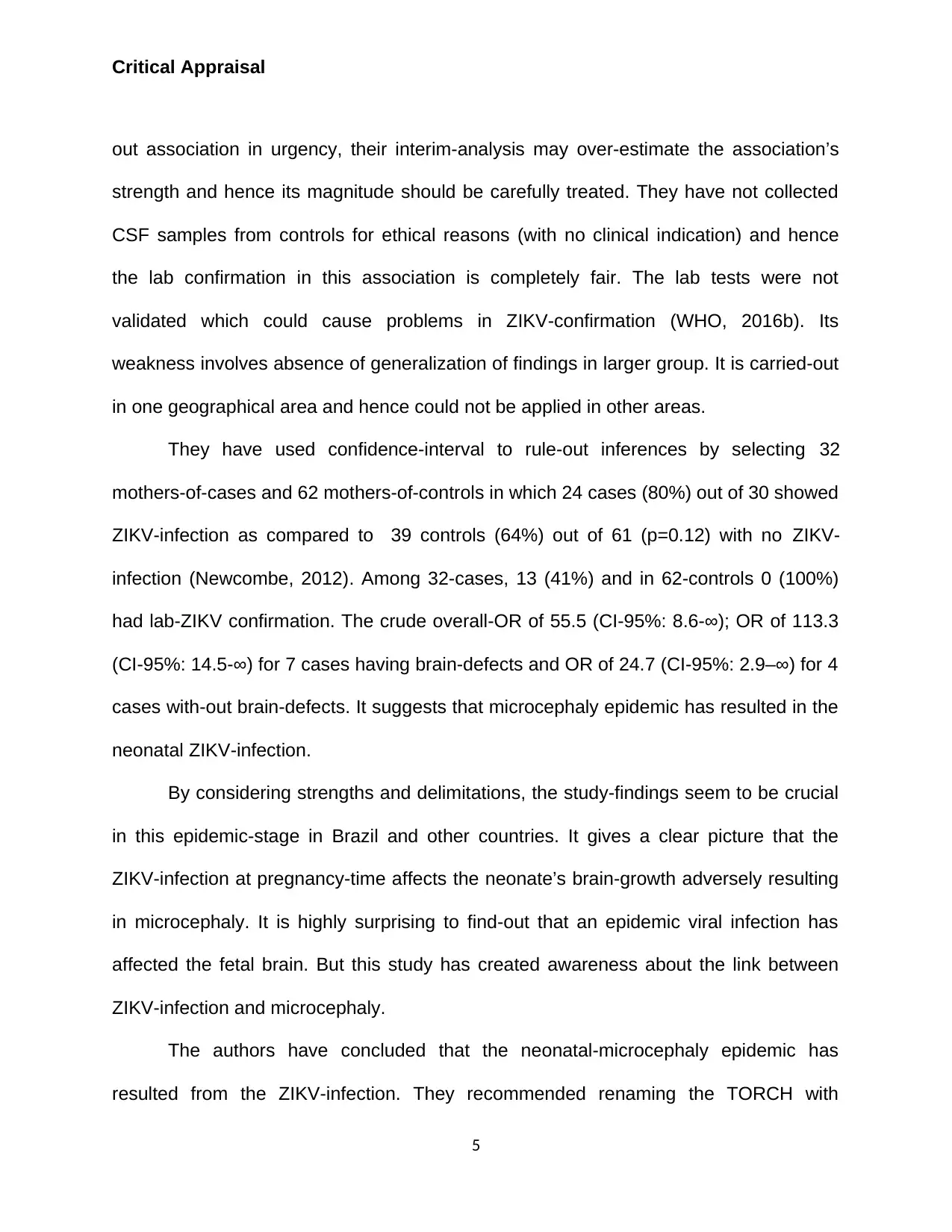
Critical Appraisal
out association in urgency, their interim-analysis may over-estimate the association’s
strength and hence its magnitude should be carefully treated. They have not collected
CSF samples from controls for ethical reasons (with no clinical indication) and hence
the lab confirmation in this association is completely fair. The lab tests were not
validated which could cause problems in ZIKV-confirmation (WHO, 2016b). Its
weakness involves absence of generalization of findings in larger group. It is carried-out
in one geographical area and hence could not be applied in other areas.
They have used confidence-interval to rule-out inferences by selecting 32
mothers-of-cases and 62 mothers-of-controls in which 24 cases (80%) out of 30 showed
ZIKV-infection as compared to 39 controls (64%) out of 61 (p=0.12) with no ZIKV-
infection (Newcombe, 2012). Among 32-cases, 13 (41%) and in 62-controls 0 (100%)
had lab-ZIKV confirmation. The crude overall-OR of 55.5 (CI-95%: 8.6-∞); OR of 113.3
(CI-95%: 14.5-∞) for 7 cases having brain-defects and OR of 24.7 (CI-95%: 2.9–∞) for 4
cases with-out brain-defects. It suggests that microcephaly epidemic has resulted in the
neonatal ZIKV-infection.
By considering strengths and delimitations, the study-findings seem to be crucial
in this epidemic-stage in Brazil and other countries. It gives a clear picture that the
ZIKV-infection at pregnancy-time affects the neonate’s brain-growth adversely resulting
in microcephaly. It is highly surprising to find-out that an epidemic viral infection has
affected the fetal brain. But this study has created awareness about the link between
ZIKV-infection and microcephaly.
The authors have concluded that the neonatal-microcephaly epidemic has
resulted from the ZIKV-infection. They recommended renaming the TORCH with
5
out association in urgency, their interim-analysis may over-estimate the association’s
strength and hence its magnitude should be carefully treated. They have not collected
CSF samples from controls for ethical reasons (with no clinical indication) and hence
the lab confirmation in this association is completely fair. The lab tests were not
validated which could cause problems in ZIKV-confirmation (WHO, 2016b). Its
weakness involves absence of generalization of findings in larger group. It is carried-out
in one geographical area and hence could not be applied in other areas.
They have used confidence-interval to rule-out inferences by selecting 32
mothers-of-cases and 62 mothers-of-controls in which 24 cases (80%) out of 30 showed
ZIKV-infection as compared to 39 controls (64%) out of 61 (p=0.12) with no ZIKV-
infection (Newcombe, 2012). Among 32-cases, 13 (41%) and in 62-controls 0 (100%)
had lab-ZIKV confirmation. The crude overall-OR of 55.5 (CI-95%: 8.6-∞); OR of 113.3
(CI-95%: 14.5-∞) for 7 cases having brain-defects and OR of 24.7 (CI-95%: 2.9–∞) for 4
cases with-out brain-defects. It suggests that microcephaly epidemic has resulted in the
neonatal ZIKV-infection.
By considering strengths and delimitations, the study-findings seem to be crucial
in this epidemic-stage in Brazil and other countries. It gives a clear picture that the
ZIKV-infection at pregnancy-time affects the neonate’s brain-growth adversely resulting
in microcephaly. It is highly surprising to find-out that an epidemic viral infection has
affected the fetal brain. But this study has created awareness about the link between
ZIKV-infection and microcephaly.
The authors have concluded that the neonatal-microcephaly epidemic has
resulted from the ZIKV-infection. They recommended renaming the TORCH with
5
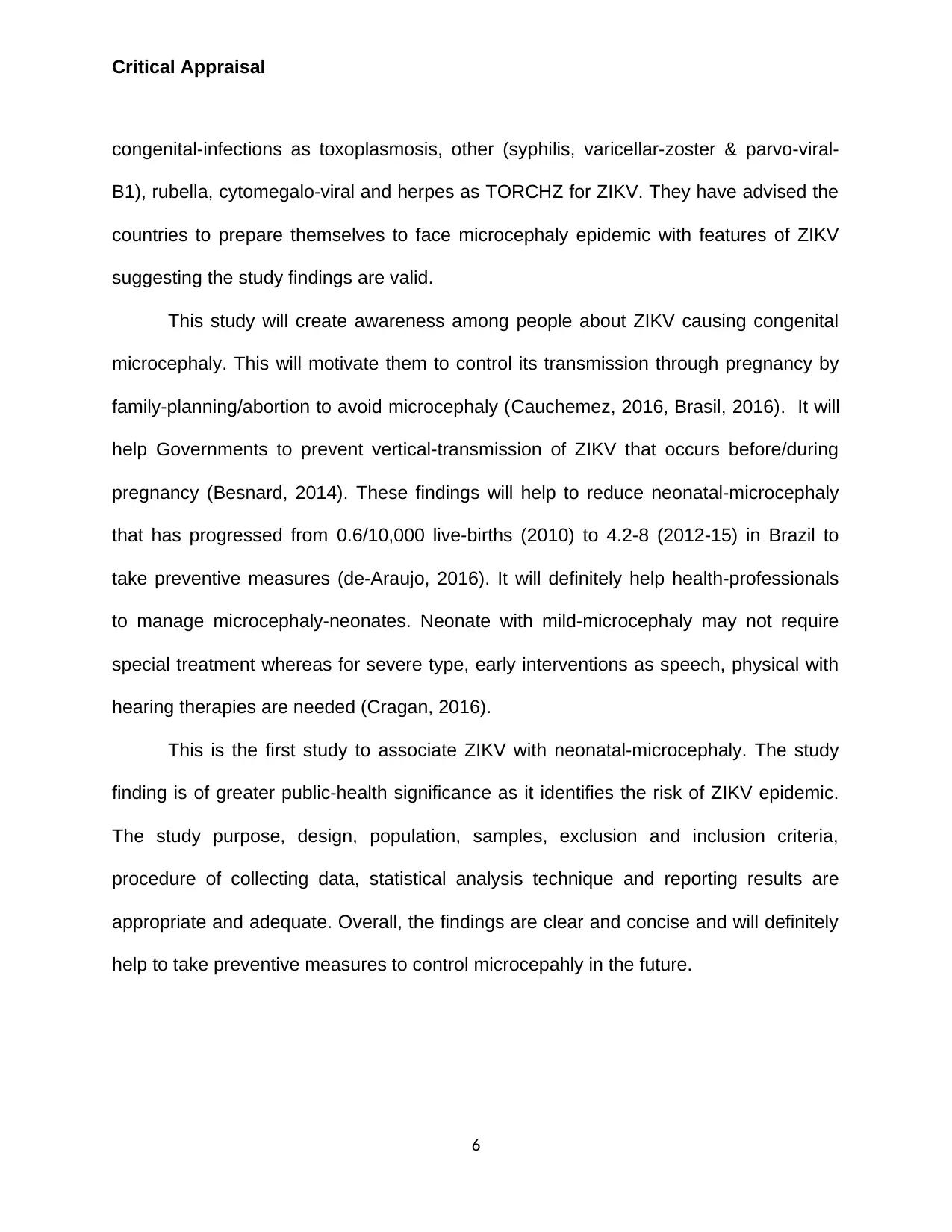
Critical Appraisal
congenital-infections as toxoplasmosis, other (syphilis, varicellar-zoster & parvo-viral-
B1), rubella, cytomegalo-viral and herpes as TORCHZ for ZIKV. They have advised the
countries to prepare themselves to face microcephaly epidemic with features of ZIKV
suggesting the study findings are valid.
This study will create awareness among people about ZIKV causing congenital
microcephaly. This will motivate them to control its transmission through pregnancy by
family-planning/abortion to avoid microcephaly (Cauchemez, 2016, Brasil, 2016). It will
help Governments to prevent vertical-transmission of ZIKV that occurs before/during
pregnancy (Besnard, 2014). These findings will help to reduce neonatal-microcephaly
that has progressed from 0.6/10,000 live-births (2010) to 4.2-8 (2012-15) in Brazil to
take preventive measures (de-Araujo, 2016). It will definitely help health-professionals
to manage microcephaly-neonates. Neonate with mild-microcephaly may not require
special treatment whereas for severe type, early interventions as speech, physical with
hearing therapies are needed (Cragan, 2016).
This is the first study to associate ZIKV with neonatal-microcephaly. The study
finding is of greater public-health significance as it identifies the risk of ZIKV epidemic.
The study purpose, design, population, samples, exclusion and inclusion criteria,
procedure of collecting data, statistical analysis technique and reporting results are
appropriate and adequate. Overall, the findings are clear and concise and will definitely
help to take preventive measures to control microcepahly in the future.
6
congenital-infections as toxoplasmosis, other (syphilis, varicellar-zoster & parvo-viral-
B1), rubella, cytomegalo-viral and herpes as TORCHZ for ZIKV. They have advised the
countries to prepare themselves to face microcephaly epidemic with features of ZIKV
suggesting the study findings are valid.
This study will create awareness among people about ZIKV causing congenital
microcephaly. This will motivate them to control its transmission through pregnancy by
family-planning/abortion to avoid microcephaly (Cauchemez, 2016, Brasil, 2016). It will
help Governments to prevent vertical-transmission of ZIKV that occurs before/during
pregnancy (Besnard, 2014). These findings will help to reduce neonatal-microcephaly
that has progressed from 0.6/10,000 live-births (2010) to 4.2-8 (2012-15) in Brazil to
take preventive measures (de-Araujo, 2016). It will definitely help health-professionals
to manage microcephaly-neonates. Neonate with mild-microcephaly may not require
special treatment whereas for severe type, early interventions as speech, physical with
hearing therapies are needed (Cragan, 2016).
This is the first study to associate ZIKV with neonatal-microcephaly. The study
finding is of greater public-health significance as it identifies the risk of ZIKV epidemic.
The study purpose, design, population, samples, exclusion and inclusion criteria,
procedure of collecting data, statistical analysis technique and reporting results are
appropriate and adequate. Overall, the findings are clear and concise and will definitely
help to take preventive measures to control microcepahly in the future.
6
⊘ This is a preview!⊘
Do you want full access?
Subscribe today to unlock all pages.

Trusted by 1+ million students worldwide
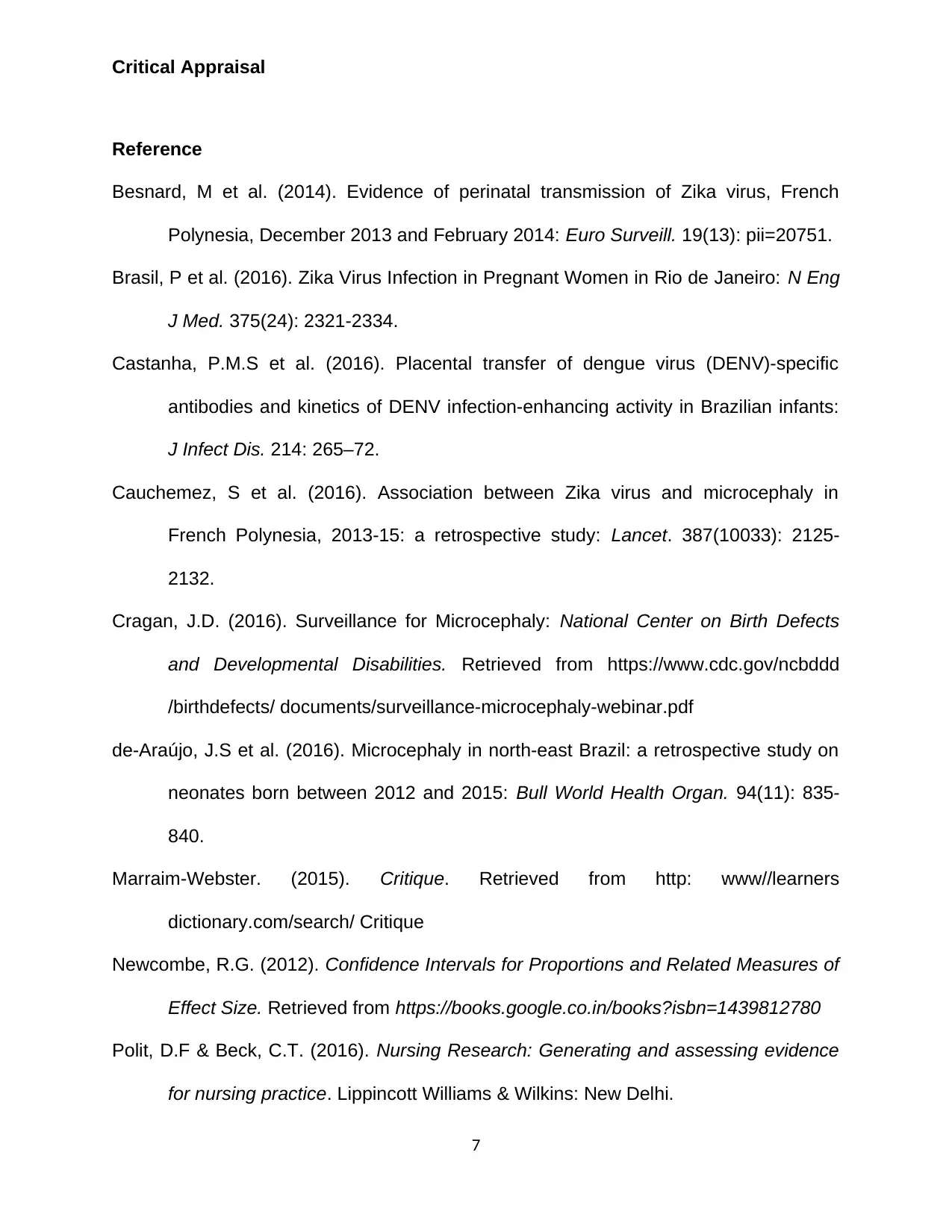
Critical Appraisal
Reference
Besnard, M et al. (2014). Evidence of perinatal transmission of Zika virus, French
Polynesia, December 2013 and February 2014: Euro Surveill. 19(13): pii=20751.
Brasil, P et al. (2016). Zika Virus Infection in Pregnant Women in Rio de Janeiro: N Eng
J Med. 375(24): 2321-2334.
Castanha, P.M.S et al. (2016). Placental transfer of dengue virus (DENV)-specific
antibodies and kinetics of DENV infection-enhancing activity in Brazilian infants:
J Infect Dis. 214: 265–72.
Cauchemez, S et al. (2016). Association between Zika virus and microcephaly in
French Polynesia, 2013-15: a retrospective study: Lancet. 387(10033): 2125-
2132.
Cragan, J.D. (2016). Surveillance for Microcephaly: National Center on Birth Defects
and Developmental Disabilities. Retrieved from https://www.cdc.gov/ncbddd
/birthdefects/ documents/surveillance-microcephaly-webinar.pdf
de-Araújo, J.S et al. (2016). Microcephaly in north-east Brazil: a retrospective study on
neonates born between 2012 and 2015: Bull World Health Organ. 94(11): 835-
840.
Marraim-Webster. (2015). Critique. Retrieved from http: www//learners
dictionary.com/search/ Critique
Newcombe, R.G. (2012). Confidence Intervals for Proportions and Related Measures of
Effect Size. Retrieved from https://books.google.co.in/books?isbn=1439812780
Polit, D.F & Beck, C.T. (2016). Nursing Research: Generating and assessing evidence
for nursing practice. Lippincott Williams & Wilkins: New Delhi.
7
Reference
Besnard, M et al. (2014). Evidence of perinatal transmission of Zika virus, French
Polynesia, December 2013 and February 2014: Euro Surveill. 19(13): pii=20751.
Brasil, P et al. (2016). Zika Virus Infection in Pregnant Women in Rio de Janeiro: N Eng
J Med. 375(24): 2321-2334.
Castanha, P.M.S et al. (2016). Placental transfer of dengue virus (DENV)-specific
antibodies and kinetics of DENV infection-enhancing activity in Brazilian infants:
J Infect Dis. 214: 265–72.
Cauchemez, S et al. (2016). Association between Zika virus and microcephaly in
French Polynesia, 2013-15: a retrospective study: Lancet. 387(10033): 2125-
2132.
Cragan, J.D. (2016). Surveillance for Microcephaly: National Center on Birth Defects
and Developmental Disabilities. Retrieved from https://www.cdc.gov/ncbddd
/birthdefects/ documents/surveillance-microcephaly-webinar.pdf
de-Araújo, J.S et al. (2016). Microcephaly in north-east Brazil: a retrospective study on
neonates born between 2012 and 2015: Bull World Health Organ. 94(11): 835-
840.
Marraim-Webster. (2015). Critique. Retrieved from http: www//learners
dictionary.com/search/ Critique
Newcombe, R.G. (2012). Confidence Intervals for Proportions and Related Measures of
Effect Size. Retrieved from https://books.google.co.in/books?isbn=1439812780
Polit, D.F & Beck, C.T. (2016). Nursing Research: Generating and assessing evidence
for nursing practice. Lippincott Williams & Wilkins: New Delhi.
7
Paraphrase This Document
Need a fresh take? Get an instant paraphrase of this document with our AI Paraphraser
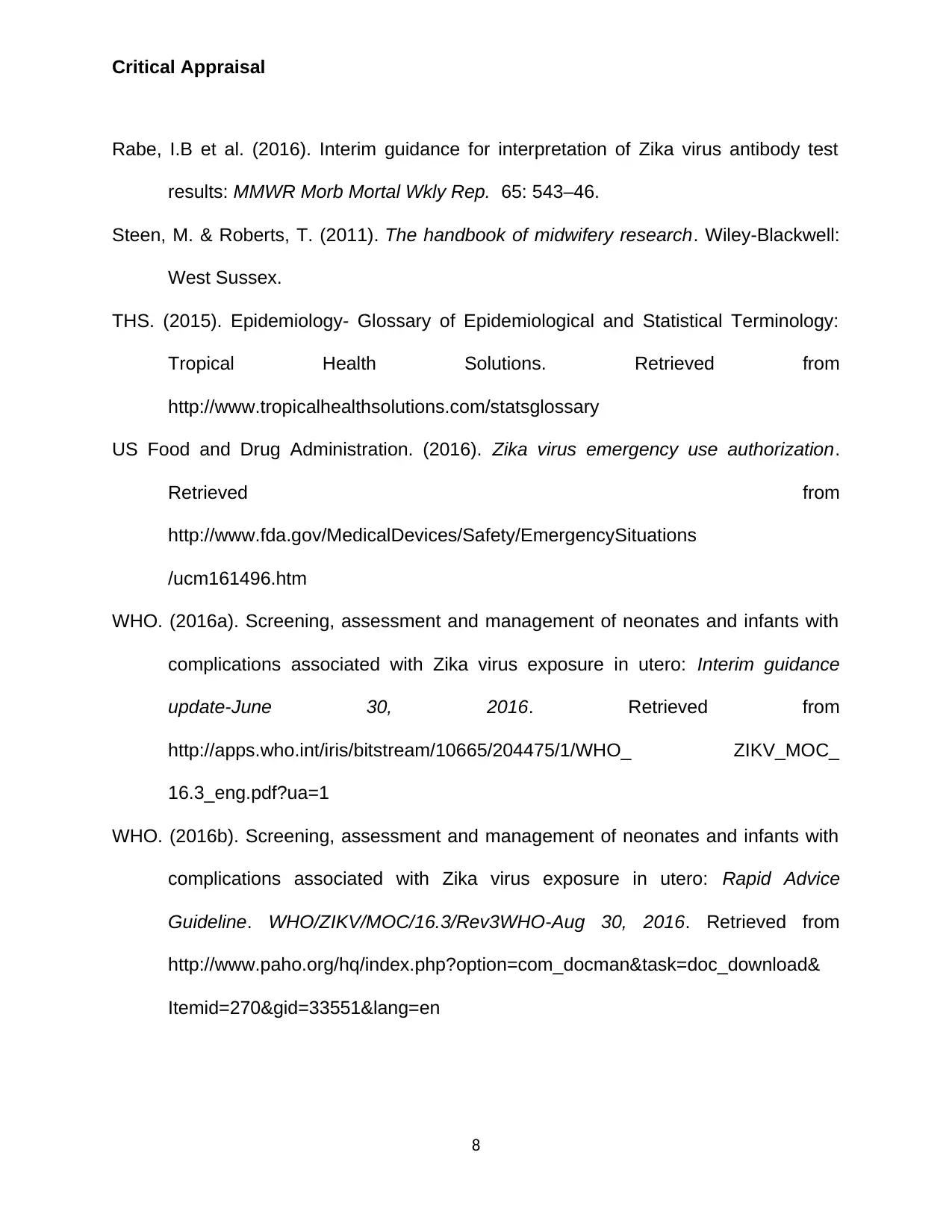
Critical Appraisal
Rabe, I.B et al. (2016). Interim guidance for interpretation of Zika virus antibody test
results: MMWR Morb Mortal Wkly Rep. 65: 543–46.
Steen, M. & Roberts, T. (2011). The handbook of midwifery research. Wiley-Blackwell:
West Sussex.
THS. (2015). Epidemiology- Glossary of Epidemiological and Statistical Terminology:
Tropical Health Solutions. Retrieved from
http://www.tropicalhealthsolutions.com/statsglossary
US Food and Drug Administration. (2016). Zika virus emergency use authorization.
Retrieved from
http://www.fda.gov/MedicalDevices/Safety/EmergencySituations
/ucm161496.htm
WHO. (2016a). Screening, assessment and management of neonates and infants with
complications associated with Zika virus exposure in utero: Interim guidance
update-June 30, 2016. Retrieved from
http://apps.who.int/iris/bitstream/10665/204475/1/WHO_ ZIKV_MOC_
16.3_eng.pdf?ua=1
WHO. (2016b). Screening, assessment and management of neonates and infants with
complications associated with Zika virus exposure in utero: Rapid Advice
Guideline. WHO/ZIKV/MOC/16.3/Rev3WHO-Aug 30, 2016. Retrieved from
http://www.paho.org/hq/index.php?option=com_docman&task=doc_download&
Itemid=270&gid=33551&lang=en
8
Rabe, I.B et al. (2016). Interim guidance for interpretation of Zika virus antibody test
results: MMWR Morb Mortal Wkly Rep. 65: 543–46.
Steen, M. & Roberts, T. (2011). The handbook of midwifery research. Wiley-Blackwell:
West Sussex.
THS. (2015). Epidemiology- Glossary of Epidemiological and Statistical Terminology:
Tropical Health Solutions. Retrieved from
http://www.tropicalhealthsolutions.com/statsglossary
US Food and Drug Administration. (2016). Zika virus emergency use authorization.
Retrieved from
http://www.fda.gov/MedicalDevices/Safety/EmergencySituations
/ucm161496.htm
WHO. (2016a). Screening, assessment and management of neonates and infants with
complications associated with Zika virus exposure in utero: Interim guidance
update-June 30, 2016. Retrieved from
http://apps.who.int/iris/bitstream/10665/204475/1/WHO_ ZIKV_MOC_
16.3_eng.pdf?ua=1
WHO. (2016b). Screening, assessment and management of neonates and infants with
complications associated with Zika virus exposure in utero: Rapid Advice
Guideline. WHO/ZIKV/MOC/16.3/Rev3WHO-Aug 30, 2016. Retrieved from
http://www.paho.org/hq/index.php?option=com_docman&task=doc_download&
Itemid=270&gid=33551&lang=en
8
1 out of 8
Your All-in-One AI-Powered Toolkit for Academic Success.
+13062052269
info@desklib.com
Available 24*7 on WhatsApp / Email
![[object Object]](/_next/static/media/star-bottom.7253800d.svg)
Unlock your academic potential
Copyright © 2020–2025 A2Z Services. All Rights Reserved. Developed and managed by ZUCOL.